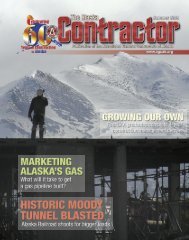Colorado Springs and El Paso County Relocation ... - Keep Trees
Colorado Springs and El Paso County Relocation ... - Keep Trees
Colorado Springs and El Paso County Relocation ... - Keep Trees
Create successful ePaper yourself
Turn your PDF publications into a flip-book with our unique Google optimized e-Paper software.
History<br />
Fort Carson was established in 1942,<br />
following Japan’s attack on Pearl Harbor.<br />
The city of <strong>Colorado</strong> <strong>Springs</strong> purchased<br />
l<strong>and</strong> south of the city <strong>and</strong> donated it to the<br />
War Department. Construction began immediately<br />
<strong>and</strong> the fi rst building, the camp<br />
headquarters, was completed Jan. 41, 1942.<br />
Camp Carson was named in honor of<br />
the legendary Army scout, Gen. Christopher<br />
“Kit” Carson, who explored much of<br />
the west in the 1800s.<br />
At the construction’s peak, nearly<br />
11,500 workers were employed on various<br />
construction projects at the new camp.<br />
Facilities were provided for 35,173 enlisted<br />
men, 1,818 offi cers <strong>and</strong> 592 nurses. Nearly<br />
all of the buildings were of the mobilization-type<br />
construction with wood-sided<br />
exteriors. The hospital was of the semi-permanent-type<br />
concrete block <strong>and</strong> had space<br />
for 1,726 beds with expansion capability of<br />
2,000 beds.<br />
The 89th Infantry Division was the<br />
fi rst major unit to be activated at Camp<br />
Carson. During World War II, more than<br />
100,000 soldiers trained here. Along with<br />
three other infantry divisions – the 71st,<br />
104th <strong>and</strong> 10th Mountain – more than<br />
125 units were activated at Camp Carson<br />
<strong>and</strong> more than 100 others were transferred<br />
to the Mountain Post from other installations.<br />
Nurses, cooks, mule packers, tank<br />
battalions, a Greek infantry battalion <strong>and</strong><br />
an Italian ordnance company – literally<br />
soldiers of every type – trained at Camp<br />
Carson during the war years.<br />
Camp Carson was also home to nearly<br />
9,000 Axis prisoners of war – mostly Ital-<br />
Soldiers<br />
Exercises <strong>and</strong> deployments continually<br />
hone the skill of Fort Carson soldiers. When not<br />
deployed, soldiers also train annually at Pinon<br />
Canyon Maneuver Site <strong>and</strong> the National Training<br />
Center at Fort Irwin, Calif.<br />
Additionally, units participate in joint<br />
exercises around the world, including Central <strong>and</strong><br />
South Africa, Europe <strong>and</strong> Southwest Asia. Since<br />
2003, most Fort Carson Units have deployed in<br />
support of the Global War on Terrorism.<br />
ians <strong>and</strong> Germans. The internment<br />
camp at Camp Carson opened Jan.<br />
1, 1943. These POWs alleviated<br />
the manpower shortage in <strong>Colorado</strong><br />
by doing general farm work, canning<br />
tomatoes, cutting corn <strong>and</strong> aiding<br />
in logging operations on <strong>Colorado</strong>’s<br />
Western Slope.<br />
Between 1942 <strong>and</strong> 1956, pack mules<br />
were a common sight at Camp Carson.<br />
The fi rst shipment arrived by train from<br />
Nebraska in July, 1942. The mules were<br />
used by fi eld artillery (pack) battalions to<br />
carry equipment, weapons <strong>and</strong> supplies<br />
over mountainous terrain.<br />
The most famous of these animals was<br />
“Hambone,” the pride of the 4th Artillery<br />
for 13 years, he carried fi rst<br />
sergeants up Ute Pass to<br />
Camp Hale. Camp Hale,<br />
located near Leadville, was<br />
where the Army conducted<br />
cold weather <strong>and</strong><br />
mountain warfare training.<br />
Hambone died in March of 1971, <strong>and</strong> was<br />
buried with full military honors.<br />
Activity at Camp Carson was greatly<br />
reduced following the end of World War II.<br />
By April 1946, the military strength at the<br />
Mountain Post had dropped to around 600.<br />
It appeared Camp Carson would be closed.<br />
With the onset of the Korean War,<br />
however, activity once again increased.<br />
Many Reserve <strong>and</strong> National Guard units<br />
were called to active duty <strong>and</strong> stationed at<br />
Camp Carson.<br />
Camp Carson became Fort Carson in<br />
1954. In the 1960s, mechanized units were<br />
Fort Carson soldiers <strong>and</strong> units have been<br />
active supporting various community events<br />
throughout <strong>Colorado</strong>. Soldiers from the<br />
Mountain Post have conducted fi refi ghting<br />
missions in the national forests, search <strong>and</strong><br />
rescue missions throughout the state, <strong>and</strong><br />
various other emergency operations. The<br />
Mountain Post is host to more than 350<br />
community events such as parades, concerts<br />
<strong>and</strong> fairs every year.<br />
Statue of the legendary<br />
Gen. Christopher “Kit” Carson.<br />
assigned to the Mountain Post. At<br />
this time, additional training l<strong>and</strong> was<br />
purchased bringing the post to its current<br />
size of 140,000 acres. Throughout its<br />
history, Fort Carson has been home to nine<br />
divisions.<br />
An additional training area, comprising<br />
237,000 acres, was purchased in 1983.<br />
Named the Pinon Canyon Maneuver Site,<br />
this training area is located about 100<br />
miles to the southeast <strong>and</strong> is used for large<br />
force-on-force maneuver training. Comprehensive<br />
maneuver <strong>and</strong> live-fi re training also<br />
occurs downrange at Fort Carson.<br />
40 <strong>Colorado</strong> <strong>Springs</strong> <strong>Relocation</strong> GUIDE 2007

















